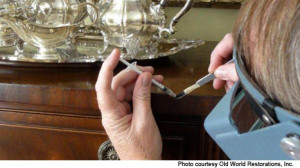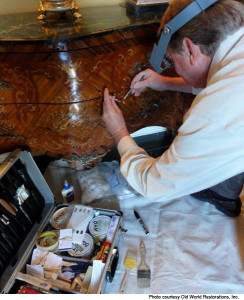 Sometimes the best approach is for a restorer to work in your home.
Sometimes the best approach is for a restorer to work in your home.
Antique furniture and mixed-media objects are often among the more challenging projects to restore and preserve due to the combination of materials that may have been used to create them. In general, the furniture that my associates and I are called upon to repair and restore suffers from special problems or is very unique in its decoration. Keep in mind that we are not refinishers; rather, we strive to retain the integrity of the original finish, gold leaf or hand-painted surfaces.
Our restorers are able to preserve paper mâché, wood, lacquer, stone, ivory and metal. Sometimes, the best approach is for restorers to work in your home or office where we clean, hand-polish and apply conservation treatments.
REFINISHING
Stripping and refinishing are no longer standard practice, and professional restorers are not as quick to recommend refinishing. An original finish is considered as important as any other element of a fine piece. Maintaining an original finish not only makes a piece historically accurate, providing patterns of wear and use, but it also helps a piece hold its monetary value. If you decide to refinish furniture, be aware that this process is not reversible and will diminish the value of the piece.
HOLDING VALUE
 Professional restorers have the skills and tools to do the job correctly.
Professional restorers have the skills and tools to do the job correctly.
Even if the original finish is not necessarily pleasing, any changes made to it will have monetary implications. The appearance of an early finish can be improved with proper cleaning methods and materials. (See Part 1 for details about caring for your furniture.)
When attempting to clean and restore furniture, we first identify all of the materials that were used to create the piece. Furniture may consist of components that are made of, or finished in, wood, stone, metal, acrylic, fabric, leather, gold leaf, paint and natural or synthetic resins. Each material may react differently to solvents and cleaning agents that may be chosen to restore the surface. It may not be safe to use a single product to treat an entire piece of furniture. In most cases, we suggest seeking the advice of an experienced furniture conservator.
BEST PROTECTION: GOOD QUALITY WAX
The best way to protect and maintain the original clear finish on furniture is an annual application of a good quality paste wax made of carnauba or micro-crystalline wax. After proper cleaning, a furniture conservator will apply a thin layer of paste wax that is buffed by hand to restore a deep luster to the original finish. Some paste wax is available in different colors to make small nicks and scratches less noticeable after polishing.
Water-based finishes may be sensitive and easily damaged by paste wax, which can contain solvents. It is always a good idea to test a small area before applying wax over an entire surface. After waxing, easily maintain the surface by hand buffing with a slightly dampened, clean, soft cloth.